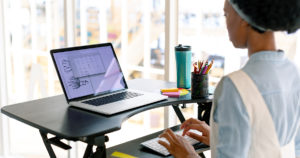Standing throughout the day is a wonderful way to improve your circulation, boost your energy and lower the risks of chronic conditions. It helps engage inactive muscles, leading to better posture and a stronger core.
Find a primary care provider
So, stand up.
Right now. Do it. Get out of your chair and stand up.
Congratulations!
You’ve made your first move toward a healthier lifestyle.
Benefits of standing
Standing six hours a day burns 50 more calories than sitting for the same amount of time – but you don’t have to go from zero to six on the first day or even the first month. You don’t even have to do all six hours at once to start improving your health and posture.
“Over a year, [those calories] could be five pounds lost for an average-sized person,” said Jaime McCarthy, a physical therapist at OSF HealthCare.
The very thought of standing for six hours might be daunting. You may be wondering, How am I going to stand for that long? But it’s important to remember that the average American sits for more than eight hours a day, according to the Centers for Disease Control. Between the two, it’s better to stand.
“You burn about .15 more calories per minute standing instead of sitting,” said Jaime. “It’s not a quick fix. You’re not standing to replace an exercise program. But it’s a good place to start.”
Potential weight loss is not the only thing about standing. Medical research studies show that standing as little as 30 minutes a day can lower your risk of death from cardiovascular disease. Standing for 90 minutes can reduce that risk by more than 33%.
Is standing all day good for you?
Standing for some periods is beneficial. But it’s not good for our bodies to be in one position, whether lying, sitting or standing, for extended periods of time.

“When you stand, you’re engaging all your postural muscles, which could prevent you from having back and neck pain in the future,” Jaime said. “When sitting, you don’t have to engage too many muscles. You may lean on the armrest, lean back or lean forward on your desk. You don’t engage your core. Never engaging those muscles leads to increased stress on the joints, and that can lead to pain.
How much sitting is too much?
The exact threshold of “too much sitting” can vary depending on sources, but here’s a consensus based on current health research:
- More than eight hours of sitting per day, especially without breaks, is associated with a much higher risk of health problems.
- Six or more hours of uninterrupted sitting has also shown negative health impacts, particularly if you don’t regularly exercise or have scheduled activities.
It’s not only how much you sit, but how long you go without standing or moving. Incorporating more standing time into your routine can enhance your focus and make you feel less fatigued.
What are some of the symptoms of sitting too long?
Sitting too much or for prolonged periods can lead to a range of negative health effects. Here are the key symptoms and consequences:
- Back, neck and shoulder pain due to slouching, tight hip flexors, weakened glutes and increased risk of herniated discs
- Swelling in legs, ankles or deep vein thrombosis (DVT) or symptoms of poor circulation and lymphatic drainage
- Muscle weakness or atrophy from lack of use and reduced bone density over time
- Stiffening joints due to reduced flexibility and mobility, which can lead to pain in the knees, hips and spine
- Stiffening connective tissue bands (septa), which pull down and create the “dimpled” look of cellulite
- Increased pressure in the rectal area, reduced blood flow and increased risk of obesity can lead to or worsen hemorrhoids
Add a little movement
Incorporate microbreaks into your day by taking a moment every 20-30 minutes from sitting at your desk or on the couch. It’s a simple habit that supports long-term focus, posture and well-being.
Examples of microbreaks that incorporate movement into your day include:
- Making regular trips for coffee or water
- Positioning your printer away from your desk
- Rotating tasks to break up long periods of sitting
- Standing during phone calls
- Taking walking meetings
- Visiting others in person instead of texting, emailing or calling
- Using a standing desk
“When standing, you have to engage your core. There’s no other way to stand. Instead of allowing those muscles to weaken, you’re gaining strength and putting less stress on the joints.”
You can also get the benefit of using a standing desk. With a standing desk, you can reverse the situation and take microbreaks where you sit down and rest.
“It doesn’t necessarily make you stronger, but it helps keep what you have,” Jaime said. “To build muscle, you want to increase your load, like with a weight or providing some resistance.”
Whether you’re working in an office or at home, or even while you’re sitting and reading or watching television, you can set your watch or cellphone to alert you once every 30 minutes to an hour.
“Just the act of standing up – getting out of your chair to a standing position – increases your blood flow, alertness and productivity,” Jamie said. “You can stand up and sit down several times, and now you’re leaning more toward actual exercise.”
Start with two minutes every day this week. Then next week, do three minutes, and so on. Once you see progress, you’ll have more incentive to keep increasing your time.
“An object in motion stays in motion. So, keep your body moving. Just a little extra movement in your day helps. Little changes add up to big benefits.”
Start a relationship with one of our primary care providers near you, and talk to them about how you can stay healthy and on the move.
Last Updated: June 18, 2025
